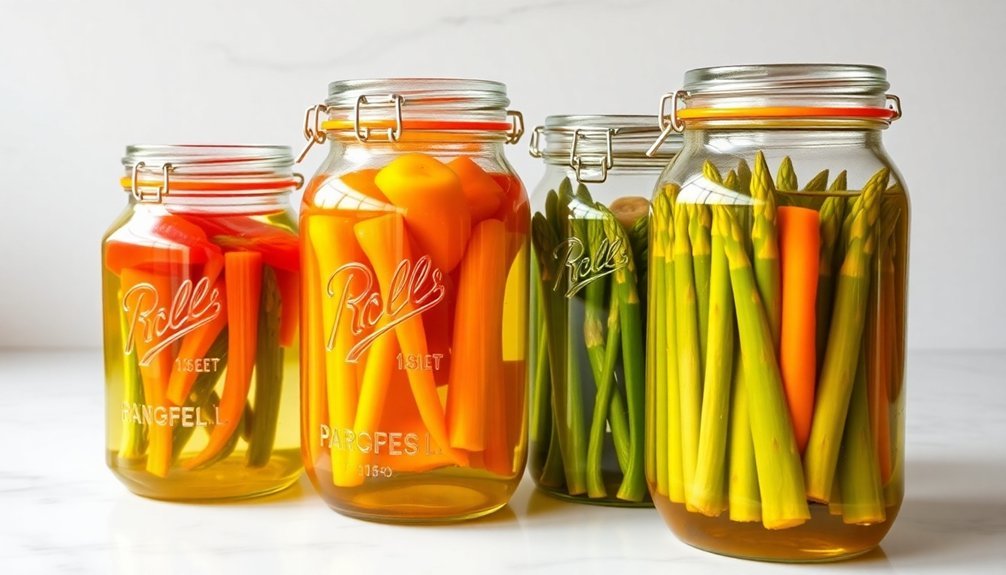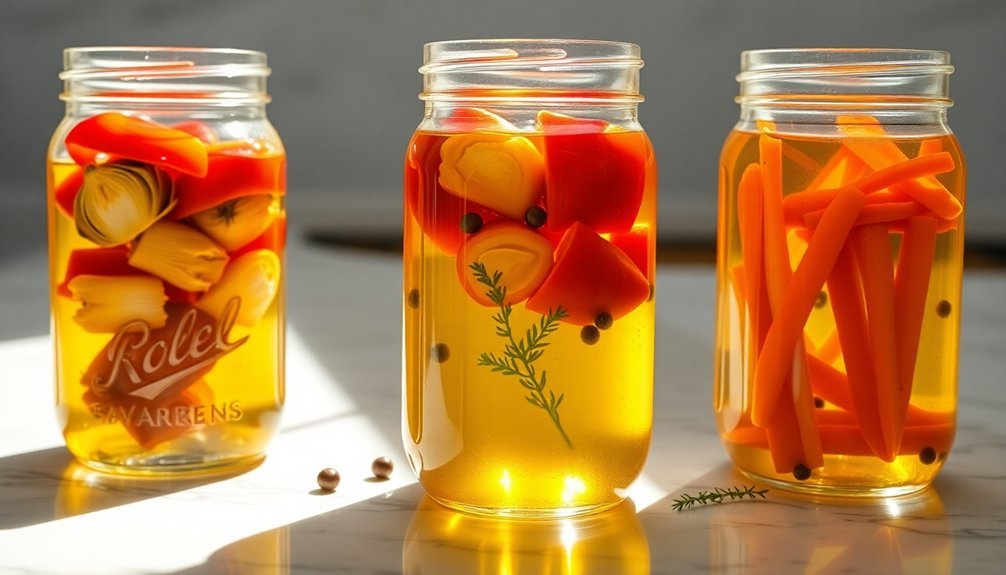For oil-packed vegetables, you'll find the best preservation with Infinity Jars' ultraviolet glass containers, which block harmful light and maintain freshness for up to 2 years. Traditional broad-mouthed canning jars with glass lids and metal clips offer reliable airtight storage. Colored glass bottles in green or yellow provide excellent UV protection for oil-based contents. Commercial-grade dispensers feature non-drip spouts and durable construction for both home and professional use. For smaller portions, squat bulb jars with specialized sealing mechanisms work perfectly. Understanding the specific features of each container type will help you make the most informed choice for your preservation needs.
Top Glass Container Picks

The right glass container can make or break your oil-packed vegetable preservation efforts. When choosing the perfect vessel, you'll want to take into account options that maximize shelf life while maintaining food safety and flavor.
Infinity Jars stand out as a premium choice, featuring European Ultraviolet Glass that blocks harmful visible light while allowing beneficial UVA and infrared rays to pass through. Their airtight design with BPA-free screw tops and convenient pour spouts helps preserve contents for over two years. The generous 1-liter capacity makes them ideal for storing larger quantities of preserved vegetables.
Broad-mouthed canning jars offer a reliable traditional option. You'll need to ascertain they've glass lids with metal clips or screw caps, and that the gaskets are intact for an airtight seal. Remember to sterilize these jars thoroughly before use and fill them completely to eliminate air pockets.
For specialized needs, think about green or yellow glass bottles that naturally filter light and protect oil-based contents. Squat bulb jars work well for smaller portions, while long-neck bottles suit thicker dressings.
If you're looking for commercial-grade options, durable glass oil dispensers with non-drip spouts provide both functionality and style, making them perfect for home or professional use.
Essential Features To Consider
Selecting the right glass container requires careful consideration of several essential features that directly impact your oil-packed vegetables' longevity and quality.
You'll want to focus on three core aspects: material quality, protection capabilities, and practical design elements.
- Dark-colored glass (green or amber) provides superior UV protection, shielding your vegetables from light damage.
- Broad-mouthed designs with proper sealing mechanisms guarantee easy filling and airtight storage.
- Food-grade glass construction assures safety and prevents chemical leaching.
When evaluating containers, prioritize those with impermeable, non-toxic glass that's free from BPA and other harmful chemicals. These containers can be upcycled for future use, making them an environmentally conscious choice.
The container's ability to create an effective oxygen barrier is vital – look for designs with quality gaskets or screw caps that maintain an anaerobic environment.
You'll also need features that support proper moisture control and temperature regulation, such as containers that seal well in refrigerated conditions.
Don't overlook practical aspects like non-drip spouts and easy-clean surfaces.
The container should accommodate your specific needs for ventilation control and humidity adjustment, particularly if you're storing different types of vegetables.
Size and Capacity Options

Numerous size and capacity options exist for oil-packed vegetable storage, ranging from compact 4-ounce containers to bulk storage vessels over 64 ounces.
You'll find that standard household sizes include 16-ounce and 32-ounce bottles, which are perfect for storing a week's worth of marinated vegetables. For metric measurements, 200ml, 500ml, and 700ml options offer similar versatility.
If you're planning to prepare larger batches, consider 1-liter bottles or bulk storage containers. These larger vessels work well for commercial use or when you're preserving seasonal vegetables. Screw caps provide an airtight seal to maintain optimal freshness.
For portion control and sampling different vegetable combinations, mini 4-ounce bottles are ideal. You can also choose from various dimensions, such as compact bottles measuring 119mm in height and 68mm in diameter, or taller options at 174mm by 94mm.
When selecting your container, consider the size of your vegetable pieces and how much oil you'll need to properly submerge them.
Remember that standardized measurements on the containers will help you maintain consistent oil-to-vegetable ratios.
Material Quality Standards
Beyond choosing the right size container, understanding glass quality standards will determine how well your oil-packed vegetables are preserved and displayed. You'll want to guarantee your containers meet Type I or Type II glass specifications, which promise superior hydrolytic resistance and chemical stability.
- Surface Glass Test results indicate how well the inner surface resists oil interaction.
- Glass Grains Test confirms proper alkali content for long-term preservation.
- Thermal stress testing verifies the container's ability to maintain integrity during processing.
When selecting containers, look for consistent transparency throughout the glass body, as this indicates proper manufacturing and absence of impurities.
You'll need to check the neck's surface flatness to guarantee proper sealing with your chosen caps or closures. Don't settle for containers showing streaks, lines, or haziness – these defects suggest poor manufacturing control and could compromise your preserved vegetables.
The quality of raw materials directly impacts your container's performance. Top-grade containers use high-purity silica sand, soda ash, and limestone from certified suppliers.
This guarantees your glass maintains its strength and clarity while protecting your oil-packed vegetables from contamination or premature deterioration.
Storage and Handling Tips

Your glass containers' longevity depends on proper storage and handling practices. Store oil-packed vegetables in the refrigerator and use them within 4 days to prevent botulism. If you're planning for longer storage, freeze the contents immediately. You'll need to label each container with preparation and use-by dates to maintain safe food handling.
| Storage Location | Temperature | Maximum Time |
|---|---|---|
| Refrigerator | Below 40°F | 4 days |
| Freezer | Below 0°F | 6 months |
| Room Temp | Unsafe | Not recommended |
When handling your containers, keep them organized using drawer dividers or dedicated storage bins. You'll want to store lids separately to prevent damage and maintain their sealing ability. For freezing, consider using ice cube trays for portioning pesto or herb-infused oils, then transfer the frozen cubes to larger containers.
Remember to clean and thoroughly dry your containers before each use, and avoid exposing them to extreme temperature changes. If you're freezing oil-packed vegetables, leave adequate headspace for expansion and thaw them safely in the refrigerator or cold water bath when ready to use.
Frequently Asked Questions
How Long Can Oil-Packed Vegetables Stay Fresh in Glass Containers?
You'll find your oil-packed vegetables can stay fresh for 6-12 months when you store them properly in airtight glass containers, keeping them in cool, dark conditions between 50°F-70°F (10°C-21°C).
Can I Reuse the Oil From Stored Vegetables for Cooking?
While you can reuse oil from stored vegetables, it's best to strain it first and check for any signs of deterioration. You shouldn't reuse it more than once, as it may contain water and vegetable particles.
What's the Ideal Temperature Range for Storing Oil-Packed Vegetables?
You'll want to keep your oil-packed vegetables between 3.3°C and 10°C (38°F to 50°F) in your refrigerator. For ideal safety against botulism, store them below 3.3°C (38°F). Never store at room temperature.
Should Vegetables Be Cooked Before Storing Them in Oil?
Yes, you'll need to cook your vegetables before storing them in oil. This reduces bacterial growth, makes them tender, and helps them absorb flavors better. It's essential for food safety and preventing botulism.
Can Different Vegetables Be Stored Together in the Same Oil Container?
You shouldn't mix different vegetables in the same oil container. They have varying pH levels and moisture contents that can create unsafe conditions. It's best to store each vegetable separately to maintain food safety.
In Summary
Now you're equipped to choose the perfect glass container for your oil-packed vegetables. You'll get the best results by selecting a container that matches your storage needs, features an airtight seal, and meets food-grade quality standards. Remember to clean your containers thoroughly before each use and store them in a cool, dark place. With proper care, these glass containers will preserve your vegetables for months to come.





Leave a Reply